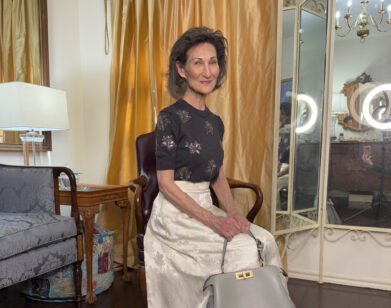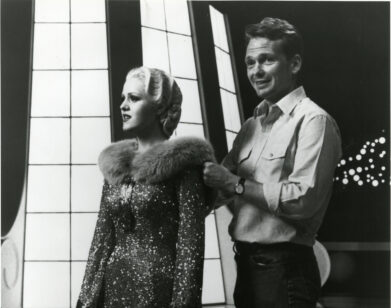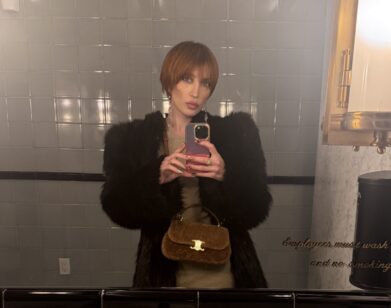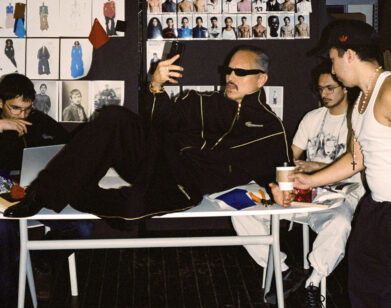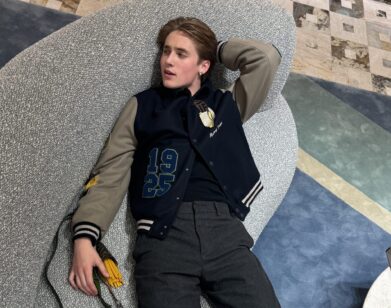Zero Waste Daniel Gave Fashion A Funeral
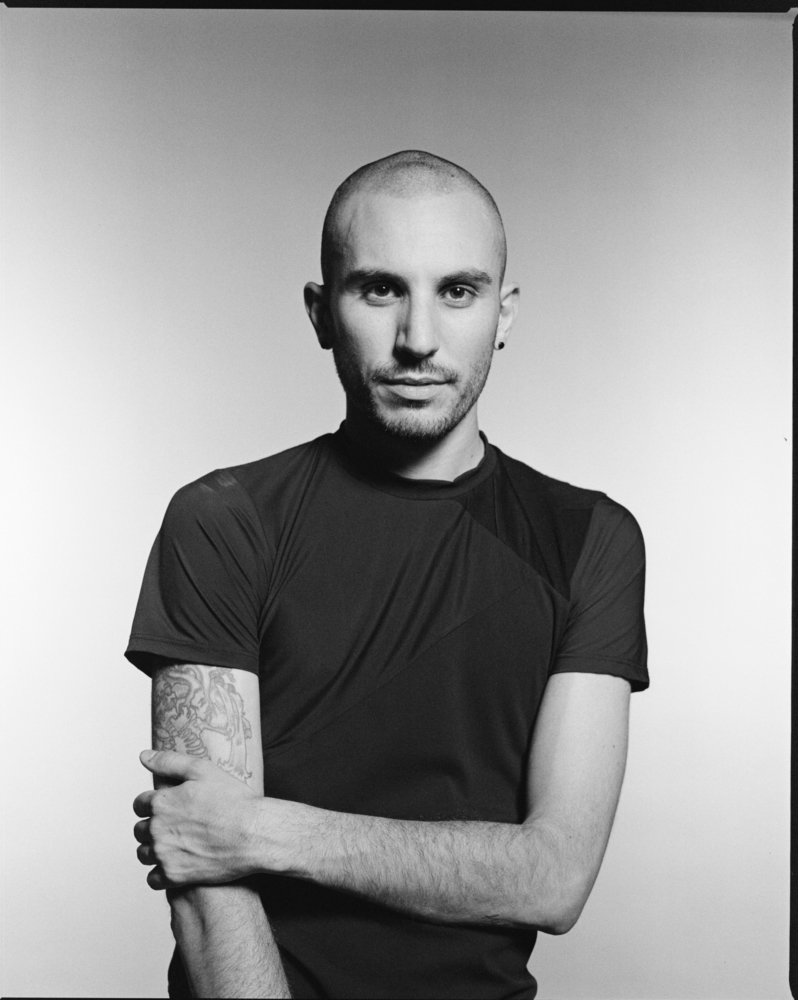
Photo by Maeghan Donohue.
Daniel Silverstein, a.k.a Zero Waste Daniel, thinks fashion is dead. He didn’t want it be this way—when he first came to New York, he was ready to take on the fashion scene with guns blazing. He went to FIT, worked for designers like Carolina Herrera, and at the end of the day, said goodbye to it all. Silverstein saw the fashion world crumble before his eyes: retail was dying, Fashion Week had become a media circus, and he struggled to square his morals with the waste and unfair wage systems endemic to the industry. He decided, in 2016, to break out with his own, radically different brand. Zero Waste Daniel collections are made by his team in Brooklyn entirely from up-cycled fabric scraps that other designers were planning on dumping in the landfill. ZWD has even begun tackling plastic pollution; last year, he partnered with the Brooklyn-based nonprofit Sure We Can to make clutches out of plastic bags. On Wednesday, Silverstein again disrupted fashion norms by putting on a radically different show that he refers to as a “fashion funeral” at the augmented reality space Arcadia Earth in lieu of the typical catwalk. The fifteen-room immersive experience featured a wailing wall, a seance, and a eulogy-turned-stand-up routine by Silverstein himself.
———
SHANTI ESCALANTE: What was your first impression when you saw the Arcadia show?
DANIEL SILVERSTEIN: I thought, finally someone is doing this. It’s the first time I’ve ever seen sustainability illustrated on an imaginative, enjoyable, and fanciful scale.
ESCALANTE: How did you start your collaboration with Arcadia?
SILVERSTEIN: Kyle (Calian), who was one of the founders of Arcadia, and I have known each other for several years. I bumped into him in the space when I was there for an event. I just said, “Man, I got to do a fashion show in here.” And he was like, “Send me an email.”
ESCALANTE: How did you start conceptualizing this show?
SILVERSTEIN: Initially I just wanted to see clothing move and interact in this space. And I always want to do something that feels relevant and experimental, especially when showing clothes.
ESCALANTE: You started doing these performances somewhat recently. Why eschew the traditional catwalk for a comedy show?
SILVERSTEIN: Some of my following is built from different media outlets that I’ve had an opportunity to participate with in the past. I did a fashion reality show all the way back in 2013. I have had a couple of videos that have gone viral on other people’s media. Me talking is a touch point with my brand for a lot of people who know me through the internet or through TV. But doing a fashion show is, by today’s standards, maybe less engaging than just talking to my own audience.
ESCALANTE: You’ve built a brand by doing things differently. Do you ever feel like an imposter?
SILVERSTEIN: I definitely took a long time to unlearn everything I had learned coming up in New York. I have a very traditional fashion upbringing—I went to FIT, interned for several major successful designers, worked retail, and did sales in a showroom in the city. So I really understand this industry. The deeper and deeper I got into it, the more I felt like I never belonged to begin with.
ESCALANTE: What was that first moment of disillusionment?
SILVERSTEIN: As a youngster in the industry, there was this sense of alarm everywhere. Designers seemed very nervous that they were going to be going out of business and that retail wasn’t performing. No one ever talked about it at their fashion shows, but it was very apparent that business was not good. Then, I was doing an internship where I was very quickly told that I couldn’t just act however I wanted to. There was a pecking order as to how this industry was going to go, and I was all the way at the bottom. I initially felt like, well, if I’m going to dedicate my life to this, I have no malintent, and I don’t feel like I’m in this for the wrong reason, why am I helping someone who I don’t agree with get to the top? So my plan was getting my hands-on experience, getting my education, and then high-tailing it out. Start building something else.
ESCALANTE: That must have been a stressful time to come up in.
SILVERSTEIN: Yeah, it just felt like everything that I had dreamed of was falling apart.
ESCALANTE: Did you know that your independent career was going to be based on sustainability? Or did you stumble on that?
SILVERSTEIN: I was always looking to do my own thing, and I always thought it would be in fashion. The sustainability component really comes from a deeply personal place. I’m the kind of person that—if I feel like I’ve done something wrong or somehow unethical or that I made a mistake—I can’t sleep at night. Being responsible for or complicit in a global system of waste and oppression was not something that I felt like I could do and be like, “Well, this is what I do to make money.” That was never going to work for me. But I knew that making things, whether I think they’re beautiful or no one thinks they’re beautiful, doesn’t have to mean harming people.
ESCALANTE: So often the conversations we have around climate change and sustainability end up being really depressing and draining. Is this why you chose to do comedy performances? Or does that come just naturally to you?
SILVERSTEIN: It’s a combination. I grew up performing. Part of my disillusionment with fashion was that no show I ever put on was ever going to fill my love of performing. And as a young entrepreneur in New York with a goal of sustainability in my business, I felt like I needed to do something that was outside of the norm of the experiences I was having—being invited to things like panel discussions and round tables at Ted-style talks. I also didn’t want to just make people feel inspired, I wanted them to leave feeling like they want to tell someone else this joke. Because that’s really spreading a movement.
ESCALANTE: What are some of the norms of the fashion world that you’ve had to unlearn?
SILVERSTEIN: The biggest ones are the technical things. Normally you have a tolerance for how off something can be when you’re sewing. If it’s more than a quarter inch off, you can send it back to the factory, never pay for it. People tell you this is how you sew, this is how you make garments, this is how you pack garments, this is how you ship garments. I’ve just had to say, I realize this material is not usable for other brands, but we’re going to take it and we’re going to work with it. I realized that each two pieces will be different and they won’t all look factory made and perfectly identical. But we’re going to not just explain that—we’re going to celebrate that.
ESCALANTE: Can you talk a bit more about how you define success?
SILVERSTEIN: In the fashion industry your metric of success is seeing your things at Fashion Week and celebrities wearing your garments. But to do that, you either need to be invited and heavily sponsored, at which point you typically lose creative control. Or you have to be independently wealthy. I had to totally relearn the metrics of success and realize that, for me, success would be if I was able to take this material, make enough shirts and sell enough shirts to be able to pay my rent and keep the lights on. Then success was, could I count how much material I was taking and then add that up to a number and prove that I was actually diverting things that were intended for landfill or that had no possibility of ever being properly recycled? Then we could see success in numbers, not just in photos of other people enjoying parties in things I made.
ESCALANTE: Right.
SILVERSTEIN: I still watch the Grammys and I still wonder, “Will I ever be dressing a celebrity who’s there?” And then I think, “Will I ever pay them to wear it?” Probably not.
ESCALANTE: Why is your show a “fashion funeral?” What are you mourning?
SILVERSTEIN: No more Fashion Week at Bryant Park. Some of the stores that I would have loved to sell my clothes to no longer exist. Some of the brands that I would have aspired to work at or be a creative director for one day have folded. There’s so much that has changed in the industry that I think it’s time to celebrate the life it had and move on to what’s next.
ESCALANTE: What do you think is the best-case and worst-case scenario for fashion’s future?
SILVERSTEIN: The best-case scenario would be a regenerative movement where we would see a change in our global perspective on the worth of material, time, and labor. Designers of all kinds of goods have the power to take waste out of the equation with their designs. They have the ability to create demand for recycled materials by incorporating them and prioritizing them in their designs. Designers and corporations alike have the ability to change the conversation about worth by re-evaluating and restructuring how we pay people and how we pay for resources and where we find them.
The worst case scenario is that we continue down the path we are on.

